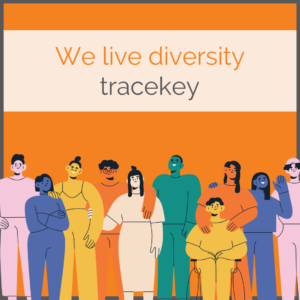
Diversity is one of the buzzwords that companies use to attract new talent. The idea behind this word – an open-minded company where every person can find their place. This sounds attractive to many people and management magazines also consider diverse teams to be more productive and successful. Of course, diverse teams are somewhat more complex and not just better than homogeneous compositions. We know that at tracekey, too. Nevertheless, one thing is certain for us and our corporate culture: we live diversity and work continuously to ensure that very different people feel comfortable with us and that cooperation benefits from diversity.
78% of respondents to a representative survey by Stepstone stated that they feel attracted to companies that describe diversity as part of their corporate culture. Therefore, diversity is well received. Diversity here means a mixture of different characteristics. These range from gender, national background, and language to age, religion, social background, or disabilities. These characteristics are commonly understood and discussed as diversity. In addition to these external or superficial characteristics, people naturally differ in areas such as competence and character. In psychology, this is referred to as “deep-level diversity”. Psychological diversity includes norms and values, knowledge. Personal characteristics such as preferred working methods or the ability to work in a team also belong to this category. All dimensions of diversity shape a team and present challenges, as studies show.
Why and how diverse teams work better
Diversity is often cited as a factor for greater productivity and results. However, diversity is much more complex and can have both advantages and disadvantages. How successful diverse teams are depends on how their members’ opinions and perspectives are managed and how much a company invests in their work.
A homogeneous team rarely challenges one’s values, opinions or working methods. For example, decisions can be made more quickly, if people are similar in terms of age, gender, and values. That is because not as many different perspectives must be considered and brought together as in diverse teams.
When assessing whether heterogeneous or homogeneous teams deliver better results, it always depends on the perspective. As well as the conditions that are created within the company. Psychological safety and an open atmosphere where everyone can freely contribute are crucial for teams composed of diverse individuals. This is because a supportive and safe environment minimizes the possibility of conflicts. It also eliminates the slight advantage homogeneous teams have.
How is diversity reflected at tracekey?
We are a team with an average age of around 37 years. Nevertheless, people of all ages are represented, from early 20s to over 60s. tracekey’s corporate language is English. This means that general meetings, internal communication, and wikis are in English. Also, this means that nobody is excluded, regardless of whether we have just one person in the company who doesn’t speak German or several.
We are not a long-established company, although we are no longer a start-up and have been around for over 10 years. This is an advantage because the way the company is structured and organized already forms the basis for successful diversity. We rely on flat hierarchies, agile working structures, and organizational principles such as Scrum. This makes it easy to bring together different perspectives, working methods, and skills.
Degrees are not that important to us
As a young company with a niche topic, we cannot reliably draw on an inexhaustible pool of applicants. On the one hand, this means that we have always hired people with very different backgrounds and considered together how they can draw from their potential. A lack of a master’s degree has never been an obstacle. On the other hand, we are not always able to actively promote diversity in the individual teams when making recruitment decisions. But this also creates opportunities: where does someone fit in, how can we put the teams together so that they work in the long term?
And where else is diversity at tracekey?
- Balanced gender ratio in the team,
- young and old work together successfully,
- due to the many international realities of life, ten other languages are spoken at tracekey in addition to German and English,
- we have a wide range of educational backgrounds, from training, lateral entry, various fields of study, retraining and international interns,
- and, of course, lots of different characters with many different skills.
Want to become part of our team? Have a look at our careers page, maybe there’s a suitable vacancy there.
If you want to learn more about our company these links might interest you:
- Baby Boom at tracekey
- Digital Teamwork: How We Work With Our Customers and Internally
- One Week in the Life of our Scrum Master